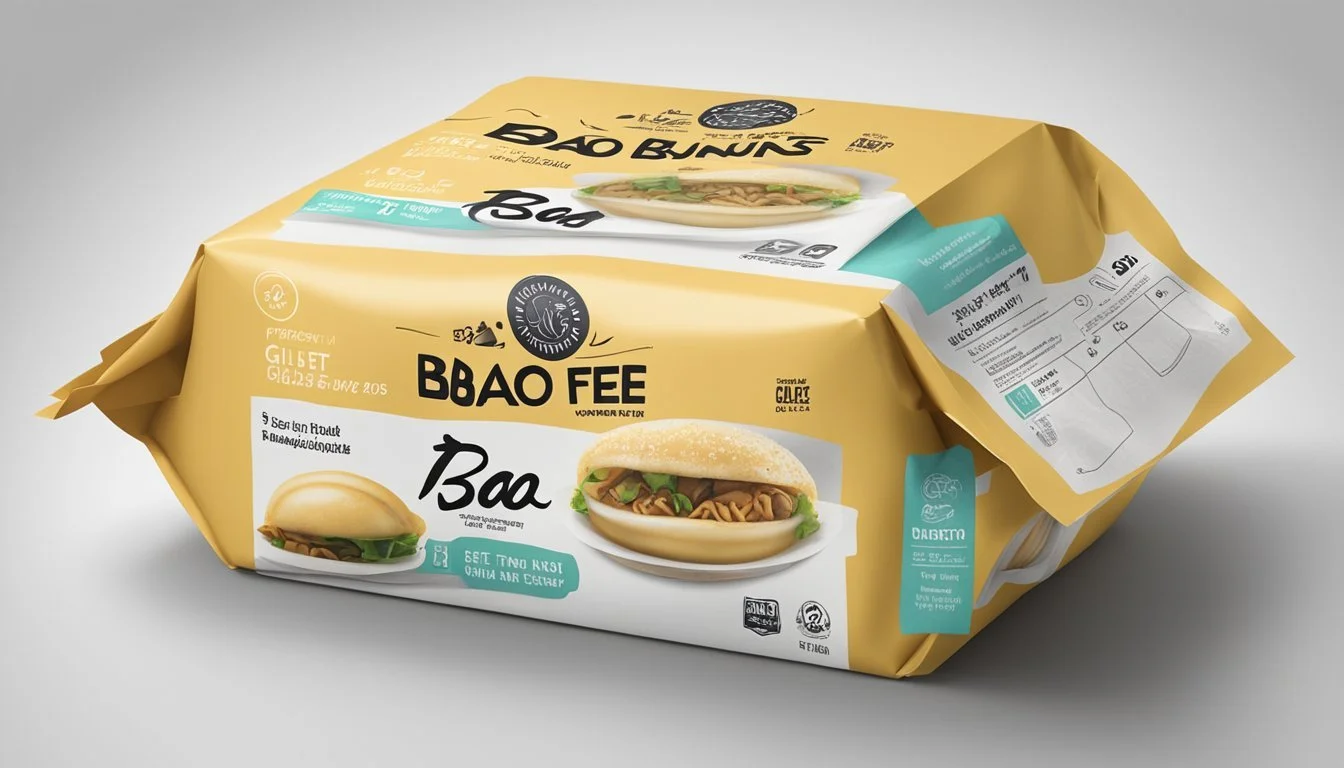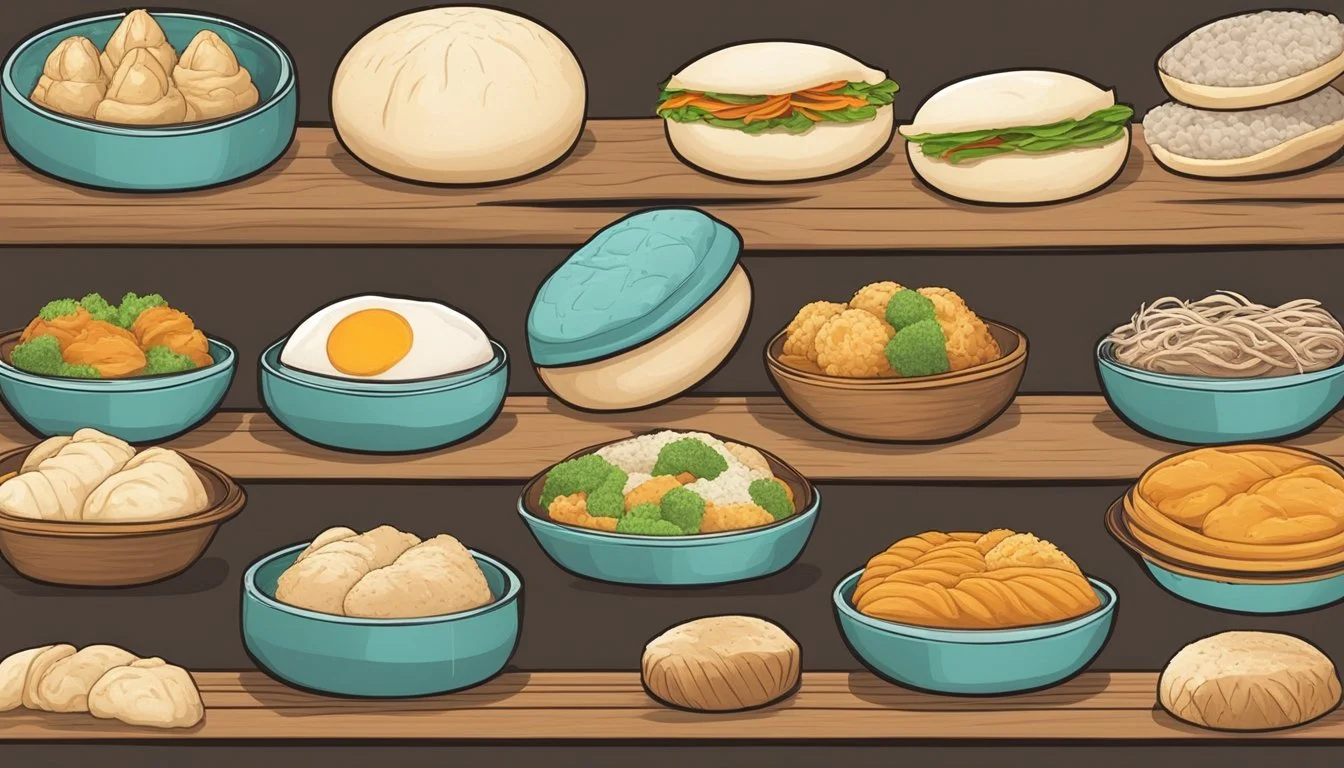How Long Do Gluten-Free Bao Buns Last?
Storage Tips and Shelf Life
Gluten-free bao buns, a delightful treat for those on a gluten-free diet, can last for several days when stored correctly. Proper storage involves keeping them in an airtight container at room temperature for up to two days, or in the refrigerator for up to five days. For longer storage, freeze the bao buns for up to three months to maintain their freshness and texture.
When considering the ingredients, gluten-free flour plays a crucial role in the longevity and quality of these buns. Using high-quality, gluten-free flour can help in achieving a dough that remains soft and fluffy even after storage. Keep in mind that the filling, whether it's meat, vegetables, or a combination, should also be stored in appropriate conditions to ensure safety and flavor retention.
By properly managing storage and using the right ingredients, you can enjoy gluten-free bao buns over a span of several days without compromising their delectable taste and texture.
Understanding Gluten-Free Bao Buns
Gluten-free bao buns replace traditional wheat flour with gluten-free alternatives. These substitutions help make the bao buns accessible to those with gluten sensitivities or celiac disease, without compromising on taste or texture.
Composition and Alternatives
Gluten-free bao buns often use a mix of gluten-free flour, rice flour, and xanthan gum. The combination is critical to mimic the elasticity and softness of traditional all-purpose flour.
Gluten-Free Flour serves as the base, providing the necessary structure. Rice Flour adds a tender texture, while Xanthan Gum is essential for binding the ingredients together, ensuring the dough is pliable and holds shape during steaming.
Additionally, alternative ingredients like mushrooms or vegetables can be used for vegetarian versions, offering great diversity in flavors and nutritional profiles.
Health Benefits
Gluten-free bao buns can be easier to digest, especially for those with gluten intolerance or celiac disease. The absence of gluten can minimize digestive issues and inflammation for sensitive individuals.
Aside from being gluten-free, these bao buns can include nutrient-rich ingredients. For example, using whole-grain rice flour can add fiber and essential vitamins. Moreover, the addition of ginger, cabbage, and other vegetables can enhance the health quotient by providing essential nutrients and antioxidants.
Thus, gluten-free bao buns can be both a delicious and a healthier alternative to traditional options.
Essential Ingredients and Substitutes
Gluten-free bao buns require specific ingredients to achieve a similar texture and taste found in traditional bao. Each component plays a critical role in ensuring the buns remain soft and flavorful.
Selecting the Right Gluten-Free Flour
The type of gluten-free flour is crucial for achieving the correct consistency. Common choices are rice flour combined with a gluten-free flour blend, which often includes ingredients like tapioca starch and potato starch to mimic the elasticity found in wheat flour.
Combining different flours enhances texture and helps the dough hold together better. Flours such as sorghum or millet can also be incorporated, depending on personal preference and dietary needs.
Yeast and Leavening Agents
Using instant yeast helps the dough rise properly, resulting in fluffy buns. Instant yeast is preferred because it does not need to be activated in water beforehand, simplifying the baking process.
Additionally, baking powder acts as a secondary leavening agent, providing an extra lift and ensuring the buns have a light and airy texture. This combination of yeast and baking powder is vital for replicating the traditional fluffiness.
Wet and Dry Components
Wet components such as milk (or a non-dairy substitute), oil, and water are essential for binding the ingredients and making the dough pliable. Milk adds richness and moisture, while oil contributes a slight tenderness to the texture.
Dry components include sugar, which feeds the yeast and adds a touch of sweetness, and salt, which enhances the flavor. The right balance between these wet and dry ingredients ensures the dough remains manageable and does not become too sticky or dry.
Preparation Techniques
Proper preparation techniques are crucial for making gluten-free bao buns. This involves creating a well-mixed dough, carefully filling and shaping each bun, and then steaming them to perfection.
Making the Dough
To make the dough, you will need gluten-free flour, rice flour, sugar, instant yeast, baking powder, xanthan gum, milk, oil, and salt. Begin by combining all the dry ingredients in a large mixing bowl.
Next, add the milk and mix until the dough is smooth using an electric mixer or a standing mixer with a hook attachment. The dough should be pliable yet firm. Once smooth, incorporate the oil and kosher salt into the mixture, ensuring even distribution before allowing the dough to rest and rise.
Filling and Shaping the Buns
Shaping and filling gluten-free bao buns require precision. Split the prepared dough into equal portions, approximately eight to nine parts depending on the required size. Gently press each portion into a flat round on a generously gluten-free floured surface.
For the filling, traditional choices include a mix of ground meat, cabbage, ginger, tamari or soy sauce, sugar, mirin, and sesame oil. Place a spoonful of filling in the center of each dough round. Carefully fold and pinch the edges to seal the filling inside, forming a bun shape. Make sure the buns are well-sealed to prevent the filling from leaking out during steaming.
Steaming Process
Steaming is essential for cooking gluten-free bao buns. Use a steamer, ensuring it is preheated to the right temperature. Line the steamer with parchment paper or cabbage leaves to prevent the buns from sticking.
Place the buns in the steamer, leaving enough space between each to allow for expansion. Steam for about 12-15 minutes until the buns are cooked through and the dough becomes fluffy. Avoid lifting the steamer lid during the process to prevent loss of steam which can affect the texture.
Proper steaming ensures that the buns are soft and moist, enhancing the overall eating experience. Always check that the filling is fully cooked before serving.
Cooking and Steaming Equipment
Preparing gluten-free bao buns requires specific tools to ensure the buns are cooked evenly and retain their delicate texture. It is crucial to choose the right steamer and consider alternative methods if a traditional steamer is not available.
Choosing the Right Steamer
Selecting the correct steamer is critical for achieving the perfect bao bun. A bamboo steamer is an excellent choice as it absorbs excess moisture, which helps to prevent the buns from becoming soggy. They are stackable, allowing multiple layers of buns to be steamed simultaneously.
Metal steamers, often made from stainless steel, are another popular option. They provide durability and easy cleaning. These steamers usually come with built-in racks that ensure even cooking by allowing the steam to circulate freely around the buns.
Both types of steamers should be placed in a large pot or wok with enough water to produce steam for the entire cooking duration. It is important to cover the steamer tightly to prevent steam from escaping.
Alternative Steaming Methods
If traditional steamers are not accessible, there are various alternative methods. Skillets with a fitted lid can be used to steam buns effectively. To do this, place a metal trivet or wire rack inside the skillet, add water, and arrange the buns on the rack. Cover with the lid and steam as usual.
Another method involves using a microwave steamer. These devices are designed specifically for steaming food in the microwave and can be a quick and convenient option. Simply place the buns in the steamer, add water according to the manufacturer's instructions, and steam in the microwave.
It is also possible to use a pressure cooker with a steamer basket. This method speeds up the cooking process. Use the 'steam' setting if available or follow the pressure cooker manual for steaming instructions.
Storing Gluten-Free Bao Buns
Proper storage of gluten-free bao buns ensures they remain fresh and delicious for as long as possible. Key methods include refrigeration for short term and freezing for more extended periods.
Refrigeration and Shelf Life
Refrigerating gluten-free bao buns helps maintain freshness for several days. Once the bao buns are completely cooled, place them in an airtight container to prevent moisture loss.
Stored this way, they typically last 3 to 4 days.
When reheating refrigerated buns, either steam them for a few minutes or microwave with a damp paper towel to retain moisture.
Keep in mind that refrigeration might affect the texture slightly, making the buns denser.
Freezing and Reheating
Freezing is ideal for longer storage. After cooling, wrap each bao bun in plastic wrap and place them in a freezer bag or an airtight container.
Label the bags with the date to track the storage time. Frozen bao buns can last up to 3 months without significant loss of quality.
For reheating, steam them directly from frozen for about 7-8 minutes or until warmed through. This method helps maintain the original soft texture of the buns. They can also be defrosted in the refrigerator overnight and steamed for a shorter period.
Creative Fillings and Flavors
Exploring different fillings for gluten-free bao buns can open up a world of flavors, from savory meats and vegetables to sweet treats. Making adjustments to fit gluten-free diets can ensure everyone enjoys these delicious morsels.
Savory Options
For savory fillings, there's a vast array of choices. Meat fillings are popular, with options like pork tenderloin marinated in a mixture of soy sauce, ginger, garlic, and sesame oil. Vegetarian fillings can include stir-fried vegetables with onion, carrot, and ginger cooked in a light vegetable oil.
Another enticing idea is to use ground meat, such as beef or chicken, blended with spices, garlic, and sometimes a hint of sweetness from hoisin sauce. Caramelized onions and mushrooms also offer a great texture contrast, giving each bite a perfect mix of flavors.
Sweet Delights
Sweet fillings for bao buns introduce a delightful contrast to the usually more savory dough. Red bean paste, made from cooked adzuki beans and sugar, is a classic option. Another sweet delight might be custard, flavored with vanilla or pandan for extra aroma.
Fruits like diced apples or mangos can be mixed with sugar and a touch of cinnamon or nutmeg, creating a juicy center. Additionally, consider using chocolate or nut spreads as a rich and creamy filling, perhaps even combining them with chopped nuts for added crunch.
Adapting Fillings to Gluten-Free Needs
Ensuring fillings are gluten-free is crucial. For meat fillings, use gluten-free soy sauce and check all spices and sauces for gluten-containing ingredients. Any flour or starches used as thickeners should be chosen carefully, opting for corn starch or tapioca starch.
When preparing vegetarian fillings, it's important to avoid cross-contamination with gluten-based products. Ensure that all vegetables and oils used are free from gluten risk.
For sweet fillings, be cautious with ingredients like sweetened condensed milk and certain flavorings that might contain gluten. Always choose certified gluten-free options for components like chocolate and custard bases to ensure a safe and enjoyable treat for everyone.
Serving and Presentation Tips
When serving gluten-free bao buns, it is important to focus on both visual appeal and complementary pairings. Proper presentation and the right condiments can enhance the dining experience and allow the flavors to shine.
Enhancing Visual Appeal
To make gluten-free bao buns visually appealing, consider using parchment paper. Placing each bao on a piece of parchment paper prevents sticking and adds a clean, professional appearance.
Arrange the buns on a large platter, spacing them evenly.
Garnishing with fresh herbs like cilantro or scallions can add a burst of color. Incorporating small dishes of dipping sauces around the platter can also create an inviting look.
Serve bao buns in small steamers or bamboo baskets for an authentic touch. This presentation method not only holds the heat but also gives the serving a traditional feel.
Pairings and Sauce Selections
Choosing the right pairings and sauces is crucial for enhancing the flavor of gluten-free bao buns. Consider offering varied sauces like soy sauce, hoisin sauce, or a spicy chili paste. A bowl of pickled vegetables, such as kimchi or pickled radish, can add a tangy element.
For a complete appetizer or snack experience, pair the buns with a light salad featuring Asian flavors. Including elements like sesame seeds, ginger, and cucumber in the salad complements the bao buns well.
Miso soup or a clear broth can also work well as a side, offering a warm and comforting balance to the steamed buns.
By paying attention to both presentation and flavor pairings, gluten-free bao buns can be elevated from simple snacks to memorable appetizers.
Common Mistakes to Avoid
When making gluten-free bao buns, certain errors can affect the texture and quality of the final product. Paying attention to dough consistency and the steaming process is crucial for achieving perfect bao buns.
Dough Consistency and Handling
Achieving the right dough consistency is vital. Many bakers make the mistake of not mixing the dough thoroughly, resulting in an uneven texture. Gluten-free dough tends to be more delicate, so it’s essential to mix thoroughly until smooth.
Over-mixing can result in a dense dough. Use a standing mixer with a hook attachment to ensure an even mix.
Properly activate the yeast by letting it rest in warm water with a bit of sugar before mixing it into the dough. This step helps the dough rise properly.
Using the right amount of xanthan gum or another thickening agent ensures the dough has the necessary elasticity without gluten.
Steaming Pitfalls
One common error is over-steaming or under-steaming the bao buns, which can cause them to become either too soggy or too dry. Steaming the buns for approximately 10-12 minutes ensures they cook evenly without losing moisture.
Using a steaming basket lined with parchment paper prevents the buns from sticking and burning. Avoid placing the buns too close together; they need space to expand.
Maintain a consistent steaming temperature to ensure even cooking. Frequent lifting of the lid allows steam to escape, disrupting the cooking process and affecting the buns' texture.
Ensuring the water level is adequate is crucial. If water runs too low, it may result in an uneven cooking temperature, leading to partially cooked or burnt bottoms.
Nutritional Information and Diet Adaptations
Gluten-free bao buns offer a nutritious and versatile option for various dietary needs including those who follow gluten-free, dairy-free, or vegan diets. The nutrient profile and adaptability to different restrictions make them a favorable choice in many cuisines.
Caloric and Macronutrient Profile
Gluten-free bao buns can vary in caloric content based on the specific ingredients used. Typically, one medium-sized bao bun contains around 150-200 calories. The macronutrient distribution generally includes:
Carbohydrates: 30-35 grams
Protein: 3-5 grams
Fat: 2-4 grams
These buns often use gluten-free flour mixtures, which can include rice flour, tapioca starch, and potato starch. Adding ingredients such as sesame oil or vegetable oil can slightly increase the fat content of the buns.
Adhering to Dietary Restrictions
Gluten-free bao buns are suitable for individuals with celiac disease or gluten sensitivity. Most recipes use xanthan gum or a gluten-free flour blend to replace traditional wheat flour. For a dairy-free version, substitute milk with plant-based alternatives like almond milk or coconut milk.
Vegan adaptations are straightforward by using plant-based milk and avoiding animal-based fillings. Instead, one might opt for tofu, mushrooms, or vegetables seasoned with soy sauce and spices.
The flexibility of gluten-free bao buns allows them to blend into various cuisines while maintaining their nutritional value. Adapting to different diets ensures they are accessible to a broader audience looking for tasty and inclusive meal options.











